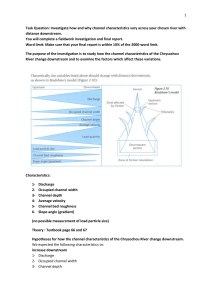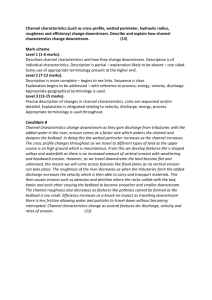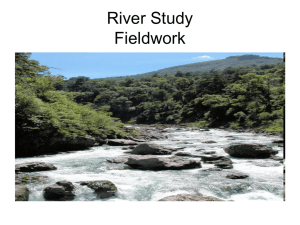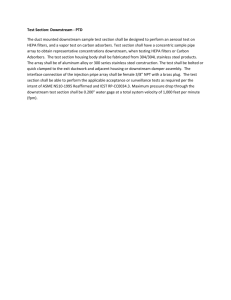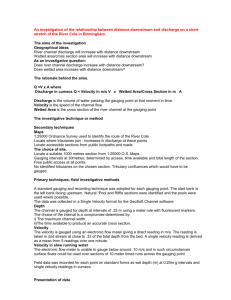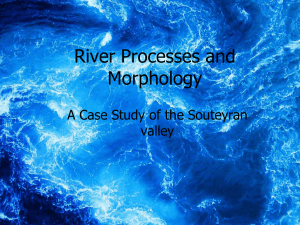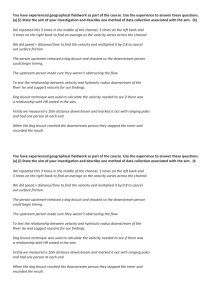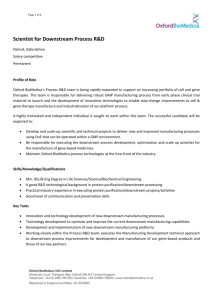Investigate how features of a river change over distance
advertisement
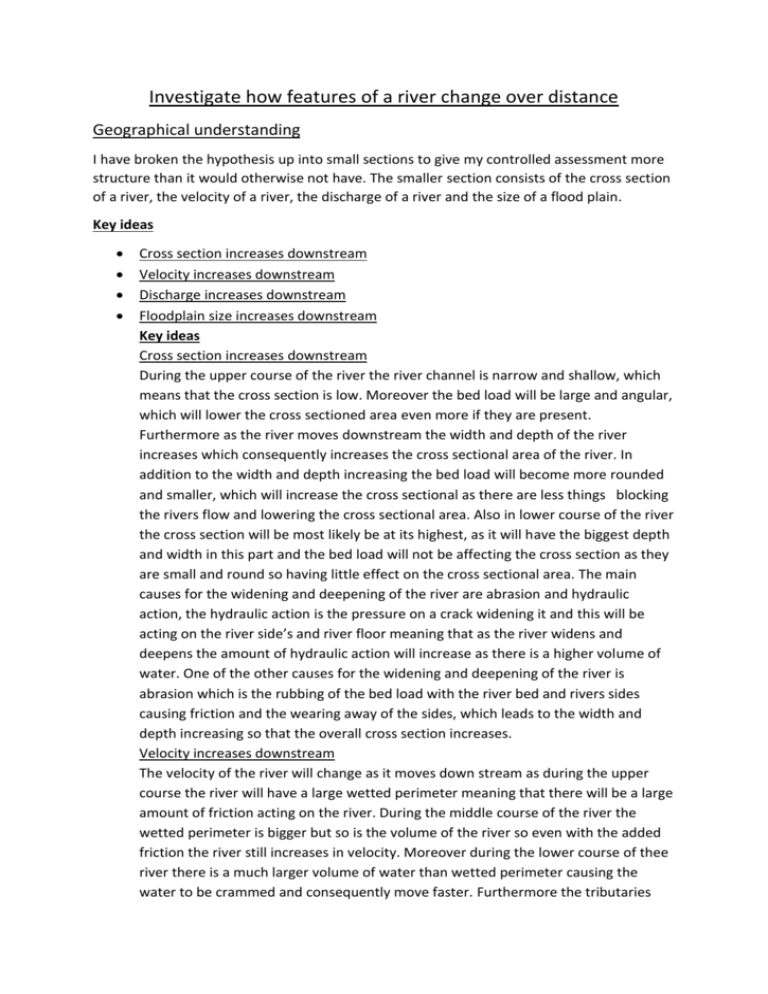
Investigate how features of a river change over distance Geographical understanding I have broken the hypothesis up into small sections to give my controlled assessment more structure than it would otherwise not have. The smaller section consists of the cross section of a river, the velocity of a river, the discharge of a river and the size of a flood plain. Key ideas Cross section increases downstream Velocity increases downstream Discharge increases downstream Floodplain size increases downstream Key ideas Cross section increases downstream During the upper course of the river the river channel is narrow and shallow, which means that the cross section is low. Moreover the bed load will be large and angular, which will lower the cross sectioned area even more if they are present. Furthermore as the river moves downstream the width and depth of the river increases which consequently increases the cross sectional area of the river. In addition to the width and depth increasing the bed load will become more rounded and smaller, which will increase the cross sectional as there are less things blocking the rivers flow and lowering the cross sectional area. Also in lower course of the river the cross section will be most likely be at its highest, as it will have the biggest depth and width in this part and the bed load will not be affecting the cross section as they are small and round so having little effect on the cross sectional area. The main causes for the widening and deepening of the river are abrasion and hydraulic action, the hydraulic action is the pressure on a crack widening it and this will be acting on the river side’s and river floor meaning that as the river widens and deepens the amount of hydraulic action will increase as there is a higher volume of water. One of the other causes for the widening and deepening of the river is abrasion which is the rubbing of the bed load with the river bed and rivers sides causing friction and the wearing away of the sides, which leads to the width and depth increasing so that the overall cross section increases. Velocity increases downstream The velocity of the river will change as it moves down stream as during the upper course the river will have a large wetted perimeter meaning that there will be a large amount of friction acting on the river. During the middle course of the river the wetted perimeter is bigger but so is the volume of the river so even with the added friction the river still increases in velocity. Moreover during the lower course of thee river there is a much larger volume of water than wetted perimeter causing the water to be crammed and consequently move faster. Furthermore the tributaries will add to the volume of the river, and so will the momentum of the river as the larger the momentum the larger the force of the river meaning that the velocity will have increased. Discharge increases downstream The discharge is the cross sectional area x the rivers average velocity at any particular point in a river, and as the river goes from the upper course to the middle and then lower courses the channel gets wider and deeper as I mentioned earlier, which will mean that the cross sectional area increases and consequently the discharge increases. Moreover the discharge increases downstream as the velocity of the river increases because of the decreased wetted perimeter which is lowered by the reduction in friction, increasing the channel efficiency. Furthermore the tributaries will add to the volume of the river, as they will increase the cross sectional area as they are adding more water to increase the volume of water within the channel of the river. Floodplain size increases downstream As the river goes downstream the volume and speed of the river increases so that when the river floods it does it with increasing strength and so as it goes downstream there will be added erosion causing the surrounding area to be eroded away and so creates a level area which gradually gets bigger as the river goes from the upper course to the middle and then to the lower course. The Bradshaw model The Bradshaw model is a diagram depicting how a rivers characteristics will change as the river progresses downstream from the source to the mouth. What I expect to see is that the cross sectional area will increase as the depth and with of the river increases, I also think that the discharge, wetted perimeter, depth and width will all also increase as it goes down stream because of increasing velocity and erosion the depth and width will increase causing the wetted perimeter and discharge to increase. Moreover, I think that the stone size/angularity, gradient slope and turbulence will decrease as the stones will become smaller and more rounded by erosion which will lead to the stones not being above water causing more turbulence and the gradient will decrease as it will be cutting downwards more at the source then by the mouth as it wants to reach sea level faster at the upper course. Map The general location of the river Goyt is located near Manchester in the north west of England. It was chosen as the place for our river study as it was possible to do in a day and showed most features a river is capable of having and meets the requirements that it has to have to use as our case study. Zoomed out view of the river Goyt and view of the county it is in = area it is located A view of the area around the studied parts of the river Goyt Mouth of the river = River = source/ mouth Source of the river
